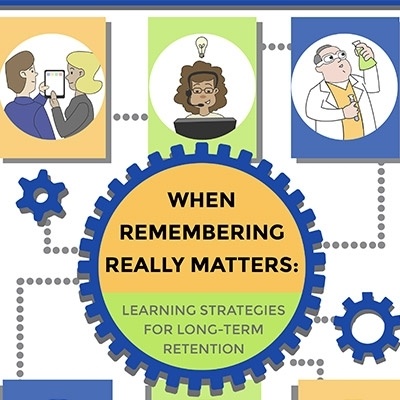Memorization Techniques For Online Learning: Ways To Boost Your Memory
When you finish reading this article, you will be able to remember any information you want in the most effective way. So, what is the basis of the effective memorization?
- A wish.
If you want to remember the information, you have to create a clear and conscious environment and intention. You just have to set the goal to remember, think about it. - Awareness.
You will need lots of awareness in order to memorize difficult information. We will address you how to use it and when. - Establish thorough connection.
If you want to remember the information, you have to make a connection with the experience and knowledge that you already have. In simple words, each new piece of information must be associated with previous knowledge. If you don’t establish the connection, then it will be difficult to find storage for it in memory. The more connections you set through the learning process, the higher are probabilities that you will remember the new information with the help of already existing ones. - Vivid impressions.
In case that you want to remember faster and to keep tracks as long as possible, you should try to process the information through the perspective of a vivid impression. - Good attention.
This is the most important part of memorizing because without attention you won’t be able to memorize. According to statistics, 80% of failure of memorization is related to insufficient attention.
Finally, it is necessary to develop skills of attention and concentration and to try to include it in previous knowledge. In this article, we present you effective methods for memorizing information, which we will analyze and talk about in the section below.
If your main goal is to strengthen the memory, the first thing that you have to do is to write down a brief summary of the paper of the material that you need to remember. For those who have good auditory and visual memory, it will be enough to listen or read the information. You have to understand that every single person has their individual qualities and different perspective for learning. That means that each one of us remembers the information in a different way. First, you have to understand what type of memory you have developed best, and then start to memorize the information.
That leads us to understand the memorization itself. In order to strengthen memory, it is highly necessary to understand how it functions.
Types Of Memorization
Here are 2 types of memorization:
- Arbitrary.
Arbitrary memorization is perfect when you have to remember some specific information. It is divided between mechanical and logical memorization. In order to remember the information, it is important to consider criteria of memorization – that will help you understand what you have learned. During the comprehension, the information enters into memory. In this particular case, you have the possibility to memorize more information, than just using the mechanical memorization technique. It is also convenient because it will save you time. - Involuntary.
The best example of involuntary memorization is a possibility to learn something like an advertising slogan, or phrase from a song. We all remember those moments when something annoying is circling in our heads, like some stupid song we heard on television.
5 Mnemonic Techniques
There are many different techniques that are used for developing and strengthening memory, but the most effective one, in the opinion of the majority, is mnemonic or mnemonic technique.
Mnemotechnics, which is the art of memorizing in Greek, is a set of methods and techniques that greatly facilitate the possibility of memorization the information, and at the same time increases the amount of memory with a help of associative connections. Mnemonics appeared at a time when people didn’t know how to write and read. With the help of it, priests and shamans memorized astronomical volume of information. It was considered that person’s ability to remember information is highly valuable. One of the most famous mnemonists was Giordano Bruno. He wrote numerous books on mnemotechnics, and the most famous one is called On the shadow of ideas. Here are the 5 techniques of mnemotechnics:
1. Rhyme Information
Rhyme is the interpretation of information made in a poetic form.
2. Forming Phrases From First Letters Of The Information
The best example of this particular technique is the sequence of words that are used to remind us of the English Alphabet, such as Alpha, Bravo, Charlie, Delta, Echo.
3. Binding Method
This mnemonic technique involves linking information with an illustration or a vivid image. You can easily memorize items when they become protagonists and characters of some action. For a more effective result, you can exagerate the size of the object (e.g. a huge kitten), or present it in the action (e.g. the chair walk), etc.
4. Hooking Method
This particular method consists of replacing numbers with an object. For example, when you have to remember number 0 – a steering wheel, 1 – a pencil, 2 – a snake, etc.
5. Cicero Method
This mnemonic technique involves the presentation of objects that have to be remembered in your familiar setting. For example, you can easily remember your room, where everything is familiar to you, and place certain objects in certain places. In order to remember the information, you just have to remember your room with the objects that are located in it.
Some techniques of mnemotechnics are more familiar to you. But we have to mention that mnemonics is a whole academic discipline with its own set of methods for better memorizing and remembering information. Mnemotechnics is ineffective if methods are used in separate ways. Therefore, in order to strengthen the memory, it is important to use several methods that we have mentioned above.
4 Techniques For The Effective Assimilation Of Texts
There are several effective methods for working with text that allows you to understand them more efficiently. The methods are based on repeated reading, but not random when you read the text too many times in a row without any logical interference, but you have to conduct meaningful work with the text.
1. The BARD Method
The BARD method gives you the possibility to assimilate and understand the text after 4 repetitions. BARD is an abbreviation of:
- Basic Thoughts.
First, you have to read the text in order to understand the basic thoughts and their mutual connections. If it is necessary, you can highlight all main thoughts. Don’t pry into the text, but try to answer yourself a question "What are basic thoughts of the text". - Attentive Reading.
When you answer the question from the first step, it is important to read the text again, but this time carefully and try to pay attention to all relevant details. Read without haste because your main task is to link all details with basic thoughts that you have found out. At this particular stage, you can use other memory techniques that you are familiar with. - Review.
Look at the text fluently, but without reading it thoroughly. Start scanning the text from the end. Think about how correctly you connected details with main thoughts. Draw parallels between your existing knowledge. In the same time, make an approximate plan of the text. In case that text is large, you can use the grid. - Debugging.
Repeat the text out loud. Begin a story with significant moments, and gradually recall all details that you have learned. After that, re-read the text again and find out what you have been missing. Think about why you missed those details. Be sure that you repeat the entire material for a few hours, and use already familiar scheduled for repetition. You have to strive to remember everything that you need to.
2. The ORRM Method
The ORRM method is slightly different than BARD especially when it comes to working with texts. ORRM is an abbreviation of the name of steps that you have to follow while working on the text.
- Orientation in the text for the purpose of highlighting the main idea.
- Repeated and attentive reading.
- Reviewing the text for the purpose of deeper understanding and awareness of both main and secondary details.
- Mental retelling with the highlighting the main thoughts.
The formulas of ORRM and BARD are very similar and both of them are known to be highly effective in comparison with the usual memorization. It is up to you which method you want to apply to your understanding.
Some methods for brain training are based on remembering image by image. The latest achievements in the field of information technology are the responsible for their creation. You can easily get acquainted with them on our website by clicking on the link that is located at the end of the article.
3. The Method Of Fast Memorization Of Text
Sometimes, there are situations where you need to read as closely as possible in order to remember the text because it is difficult to deal with its content and understanding. There are methods to work with such texts.
At first, you have to learn each method. The idea is to allocate immediately all keywords that were used in the text with less concentration on details. You should check again the Cicero system. This is especially true when you decide to memorize the text by hearing. If the text cannot be read, then you must use the successive association's method. Every text contains abstract concepts. You have to transform them into word-images in order to build your own plot and to arrange them according to your own method of learning.
In each case, it is up to you to decide which tactics you wish to apply. For example, when you study poetry, you don’t do it by lines, since there is a possibility that you will repeat the first and second one for a longer time. It is also very likely that after you finish repeating, you will return to the beginning. You should learn verses or stanzas in poetry in full, especially because poems contain rhythm and rhyme which makes them easier to remember. But if you associate the last word of a previous verse with the first word of the next one, and find the logic between them in order to throw the confusion and memorize it smoothly. The same method is used for studying parts for the monologue, role, etc.
4. The Method Of Pictograms
This method is specifically great for people who are mor e"visual" types. For example, an icon is a drawing latter, which represents a collection of graphic images that person imagines in order to memorize and reproduce expressions and words.
The pictogram method works perfectly when you want to memorize texts, including poetry. We present you an approximate plan for using pictograms when working with text:
- You should highlight key words or short expressions in the text.
- Draw an icon for each highlighted work or expression. You can call it visual association.
- It is important to understand that picture should not be too detailed or too schematic. You are not here to create a work of art with your impeccable skills and don’t add numbers or letters. For example, for the word "holiday" you can draw fireworks or a flag; for the word "sport" you can draw a ball or something else that will bring you the association to the word. The pictogram cannot be right or wrong, it is more about your perspective and idea is to give you the possibility to instantly recall the word when you see the icon.
- You can practice drawing pictograms. Think of the pictograms as a tape recorder, lemonade, magazine, pattern, order, gallery, anecdote, and then after a couple of hours, look again at pictures and try to encode the pictogram. In the same time, this skill can become great fun and very useful when you want to compile memory cards.
Now, let's get back to the text. The idea is to draw icons in the course of the text. After you finish, try to reproduce the text only by looking at pictograms, as detailed as possible. Then, if you are satisfied with results, try to reproduce the text by remembering your pictures mentally. Don’t worry; you are not cheating if you peek sometime in pictures. The more accurate pictograms you draw, the easier will be for you to recall the text. Pictograms can also be linked to a story in any way that is known to you.
Leaflets with pictograms are the perfect technique for memorizing. You just have to spread chaotic leaves along with drawings and don’t be afraid to do it in front of the teacher, because they won’t understand the meaning of your pictograms.
Working with a text is excellent for memory training. You can use these methods when working with text and after a short time; you will find the difference in your natural memory. At once, you will see that your natural memory is much better. Of course, you can easily memorize a lot without using mnemonics methods. But still, mnemonic could be useful.
Summary
A non-systematic, multiple reading of the text is unproductive. The application of methods such as BARD and ORRM in order to work with texts gives you the possibility to perceive the text by using four steps. The best methods for fast memorization of the text are mnemonic techniques. When you work on texts on the intellectual basis that will surely help you develop and improve your memory.









